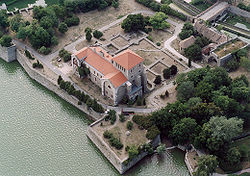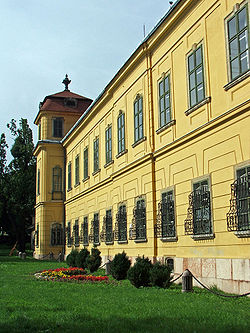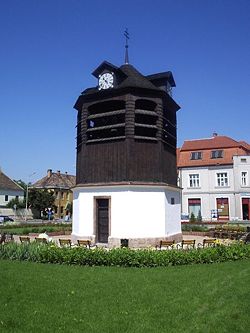
Tata, Hungary
Encyclopedia



Hungary
Hungary , officially the Republic of Hungary , is a landlocked country in Central Europe. It is situated in the Carpathian Basin and is bordered by Slovakia to the north, Ukraine and Romania to the east, Serbia and Croatia to the south, Slovenia to the southwest and Austria to the west. The...
, Komárom-Esztergom
Komárom-Esztergom
Komárom-Esztergom is an administrative Hungarian county in Transdanubia, on the northern border with Slovakia. It shares borders with the Hungarian counties of , , and...
county, 9 km (6 mi) northwest from county seat Tatabánya
Tatabánya
Tatabánya is a city of 69,988 inhabitants in north-western Hungary, in the Central Transdanubian region. It is the capital of Komárom-Esztergom County.- Location :...
.
Location
Tata is located in the valley between the Gerecse and Vértes Mountains, some 70 km (43 mi) from the BudapestBudapest
Budapest is the capital of Hungary. As the largest city of Hungary, it is the country's principal political, cultural, commercial, industrial, and transportation centre. In 2011, Budapest had 1,733,685 inhabitants, down from its 1989 peak of 2,113,645 due to suburbanization. The Budapest Commuter...
, the capital
Capital City
Capital City was a television show produced by Euston Films which focused on the lives of investment bankers in London living and working on the corporate trading floor for the fictional international bank Shane-Longman....
. By the virtue of its location, the city is a railway and road junction. Motorway M1 (E60, E75) from Vienna
Vienna
Vienna is the capital and largest city of the Republic of Austria and one of the nine states of Austria. Vienna is Austria's primary city, with a population of about 1.723 million , and is by far the largest city in Austria, as well as its cultural, economic, and political centre...
to Budapest
Budapest
Budapest is the capital of Hungary. As the largest city of Hungary, it is the country's principal political, cultural, commercial, industrial, and transportation centre. In 2011, Budapest had 1,733,685 inhabitants, down from its 1989 peak of 2,113,645 due to suburbanization. The Budapest Commuter...
passes through the outer city limits, the railway line Budapest–Vienna go through the city.
Demographics
According to the 2001 census the town has 23,937 inhabitants: 93.3% Hungarians, 1.6% Germans, 0.6% Roma, 0.2% Slovakians and 6.5% other.History
The area has been inhabited since prehistoric times; archaeological findings date back to 50,000 BCE. Later it was a RomanAncient Rome
Ancient Rome was a thriving civilization that grew on the Italian Peninsula as early as the 8th century BC. Located along the Mediterranean Sea and centered on the city of Rome, it expanded to one of the largest empires in the ancient world....
settlement.
Tata was first mentioned in 1221. Its castle was built by the Lackfi
Lackovic
The Laczkovich family is a noble family from Hungary and Croatia, which ruled Transylvania in the 14th century. The Laczkovich were the wealthiest family in 14th century Hungary, owning much of what is today Northern Croatia, Eastern Slovenia, and Western Hungary...
family and had its prime under Matthias I
Matthias Corvinus of Hungary
Matthias Corvinus , also called the Just in folk tales, was King of Hungary and Croatia from 1458, at the age of 14 until his death...
, who had it rebuilt in Renaissance
Renaissance
The Renaissance was a cultural movement that spanned roughly the 14th to the 17th century, beginning in Italy in the Late Middle Ages and later spreading to the rest of Europe. The term is also used more loosely to refer to the historical era, but since the changes of the Renaissance were not...
style.
In 1526 when the disastrous battle with the Turks happened and Louis II
Louis II of Hungary and Bohemia
Louis II was King of Hungary, Bohemia and Croatia from 1516 to 1526.- Early life :Louis was the son of Ladislaus II Jagiellon and his third wife, Anne de Foix....
died in the battlefield, Count György Cseszneky
György Cseszneky
Count György Cseszneky de Milvány et Csesznek was a Hungarian aristocrat in 16th century. Member of the Cseszneky family.In 1526 when the disastrous battle with the Turks happened and Louis II died in the battlefield, György Cseszneky was the chatelain of the Castles Tata and Komárom...
was the chatelain of the Castle Tata. In the struggle for the throne of Hungary between Voivode John Zapolya
John Zápolya
John Zápolya was King of Hungary from 1526 to 1540. His rule was disputed by Archduke Ferdinand I, who also claimed the title King of Hungary between 1526 and 1540. He was the voivode of Transylvania before his coronation.- Biography :...
and Archduke Ferdinand of Habsburg, he supported Ferdinand's claim. However, when Zápolya's commander Gáspár Ráskai laid siege to the Castle of Tata, Cseszneky unwillingly yielded to the superior force and handed the castle over.
During the Ottoman occupation
Ottoman wars in Europe
The wars of the Ottoman Empire in Europe are also sometimes referred to as the Ottoman Wars or as Turkish Wars, particularly in older, European texts.- Rise :...
the castle of Tata was an important fortress. It was captured in 1529 and had lots of different owners in the next decades until it was burnt down by the Habsburg
Habsburg
The House of Habsburg , also found as Hapsburg, and also known as House of Austria is one of the most important royal houses of Europe and is best known for being an origin of all of the formally elected Holy Roman Emperors between 1438 and 1740, as well as rulers of the Austrian Empire and...
s in retaliation for the Rákóczi's War for Independence
Rákóczi's War for Independence
Rákóczi's War for Independence was the first significant attempt to topple therule of Habsburg Austria over Hungary. The war was fought by a group of noblemen, wealthy and high-ranking progressives and was led by Francis II Rákóczi Rákóczi's War for Independence (1703–1711) was the first...
.
In 1727 Count József Esterházy bought Tata and the surrounding villages. The town prospered, in 1765 it already had a secondary school
Secondary school
Secondary school is a term used to describe an educational institution where the final stage of schooling, known as secondary education and usually compulsory up to a specified age, takes place...
.
According to the article of the Pallas Lexicon about Tata in 1851 the town was a "pretty and developing village in the Tata district of Komárom comitatus; 895 buildings, 6925 mostly Hungarian residents (3633 Roman Catholics, 2518 Lutherans and 673 Israelites), centre of the district, with secondary school, railway station, post office. Tata and the adjoining village Tóváros (4257 residents) are built around a large lake, Tata on the hillside, Tóváros on the plain. Between them there is the Esterházy mansion and an old castle with archive and gallery incl. a painting of Leonardo da Vinci. The theatre was built in 1889. The mansion is surrounded by the beautiful English garden (140 hectares)."
In 1938 the village Tóváros was annexed to the Tata which was renamed Tatatóváros for a short while; one year later it was named Tata again. It was granted town status in 1954.
Main sights
- Castle next to the Öreg-tó (Old Lake)
- The Esterházy Palace
- Heroes' Square with World War IWorld War IWorld War I , which was predominantly called the World War or the Great War from its occurrence until 1939, and the First World War or World War I thereafter, was a major war centred in Europe that began on 28 July 1914 and lasted until 11 November 1918...
monument and synagogue - Kossuth square with town hall
- The parish church of Tata
- The Capuchin church
- Calvary Hill
- Lookout tower
- Water mills
- Belfry
- The English Park
- False ruins
- Fényes Bath
Twin towns — Sister cities
Tata, Hungary is twinnedTown twinning
Twin towns and sister cities are two of many terms used to describe the cooperative agreements between towns, cities, and even counties in geographically and politically distinct areas to promote cultural and commercial ties.- Terminology :...
with:
-
 AlkmaarAlkmaarAlkmaar is a municipality and a city in the Netherlands, in the province of Noord Holland. Alkmaar is well known for its traditional cheese market. For tourists, it is a popular cultural destination.-History:...
AlkmaarAlkmaarAlkmaar is a municipality and a city in the Netherlands, in the province of Noord Holland. Alkmaar is well known for its traditional cheese market. For tourists, it is a popular cultural destination.-History:...
, NetherlandsNetherlandsThe Netherlands is a constituent country of the Kingdom of the Netherlands, located mainly in North-West Europe and with several islands in the Caribbean. Mainland Netherlands borders the North Sea to the north and west, Belgium to the south, and Germany to the east, and shares maritime borders...
, since 1985 -
 GerlingenGerlingenGerlingen is a town in the district of Ludwigsburg, Baden-Württemberg, Germany. It is situated 9 km west of Stuttgart, and 15 km southwest of Ludwigsburg, Gerlingen is home to BOSCH appliances....
GerlingenGerlingenGerlingen is a town in the district of Ludwigsburg, Baden-Württemberg, Germany. It is situated 9 km west of Stuttgart, and 15 km southwest of Ludwigsburg, Gerlingen is home to BOSCH appliances....
, GermanyGermanyGermany , officially the Federal Republic of Germany , is a federal parliamentary republic in Europe. The country consists of 16 states while the capital and largest city is Berlin. Germany covers an area of 357,021 km2 and has a largely temperate seasonal climate...
, since 1987 -
 Dammarie-les-LysDammarie-les-LysDammarie-lès-Lys is a commune in the south-eastern suburbs of Paris, France. It is located in the Seine-et-Marne department in the Île-de-France region from the center of Paris.-History:...
Dammarie-les-LysDammarie-les-LysDammarie-lès-Lys is a commune in the south-eastern suburbs of Paris, France. It is located in the Seine-et-Marne department in the Île-de-France region from the center of Paris.-History:...
, FranceFranceThe French Republic , The French Republic , The French Republic , (commonly known as France , is a unitary semi-presidential republic in Western Europe with several overseas territories and islands located on other continents and in the Indian, Pacific, and Atlantic oceans. Metropolitan France...
, since 1993 -
 ArenzanoArenzanoArenzano is a coastal town and comune in the province of Genoa, Liguria, Italy. , it has a population of 11,568. This varies a lot during the holiday seasons, since it is a reasonably popular holiday resort for Italians....
ArenzanoArenzanoArenzano is a coastal town and comune in the province of Genoa, Liguria, Italy. , it has a population of 11,568. This varies a lot during the holiday seasons, since it is a reasonably popular holiday resort for Italians....
, ItalyItalyItaly , officially the Italian Republic languages]] under the European Charter for Regional or Minority Languages. In each of these, Italy's official name is as follows:;;;;;;;;), is a unitary parliamentary republic in South-Central Europe. To the north it borders France, Switzerland, Austria and...
, since 1994 -
 SvodínSvodínSvodín is a village and municipality in the Nové Zámky District in the Nitra Region of south-west Slovakia.-History:In historical records the village was first mentioned in 1156. The town had Hungarian majority in the 17th century according to the Turkish tax census.-Geography:The municipality...
SvodínSvodínSvodín is a village and municipality in the Nové Zámky District in the Nitra Region of south-west Slovakia.-History:In historical records the village was first mentioned in 1156. The town had Hungarian majority in the 17th century according to the Turkish tax census.-Geography:The municipality...
, SlovakiaSlovakiaThe Slovak Republic is a landlocked state in Central Europe. It has a population of over five million and an area of about . Slovakia is bordered by the Czech Republic and Austria to the west, Poland to the north, Ukraine to the east and Hungary to the south...
, since 1997 -
 MontebellunaMontebellunaMontebelluna is a town and comune in Veneto, Italy, approximately 67 kilometers northwest of Venice. It has an estimated population of 30,817.Fila has research and development facilities in Montebelluna. Northwave was started by Gianni Piva in Montebelluna...
MontebellunaMontebellunaMontebelluna is a town and comune in Veneto, Italy, approximately 67 kilometers northwest of Venice. It has an estimated population of 30,817.Fila has research and development facilities in Montebelluna. Northwave was started by Gianni Piva in Montebelluna...
, ItalyItalyItaly , officially the Italian Republic languages]] under the European Charter for Regional or Minority Languages. In each of these, Italy's official name is as follows:;;;;;;;;), is a unitary parliamentary republic in South-Central Europe. To the north it borders France, Switzerland, Austria and...
, since 2000 -
 SovataSovata-History:It formed part of the Székely Land region of the historical Transylvania province. The first data about Sovata are from 1578. By 1583 it already was a village....
SovataSovata-History:It formed part of the Székely Land region of the historical Transylvania province. The first data about Sovata are from 1578. By 1583 it already was a village....
, RomaniaRomaniaRomania is a country located at the crossroads of Central and Southeastern Europe, on the Lower Danube, within and outside the Carpathian arch, bordering on the Black Sea...
, since 2002 -
 PińczówPinczówPińczów is a town in Poland, in Świętokrzyskie Voivodship, about 40 km south of Kielce. It is the capital of Pińczów County. Population is 12,304 .-History:...
PińczówPinczówPińczów is a town in Poland, in Świętokrzyskie Voivodship, about 40 km south of Kielce. It is the capital of Pińczów County. Population is 12,304 .-History:...
, PolandPolandPoland , officially the Republic of Poland , is a country in Central Europe bordered by Germany to the west; the Czech Republic and Slovakia to the south; Ukraine, Belarus and Lithuania to the east; and the Baltic Sea and Kaliningrad Oblast, a Russian exclave, to the north...
, since 2004

